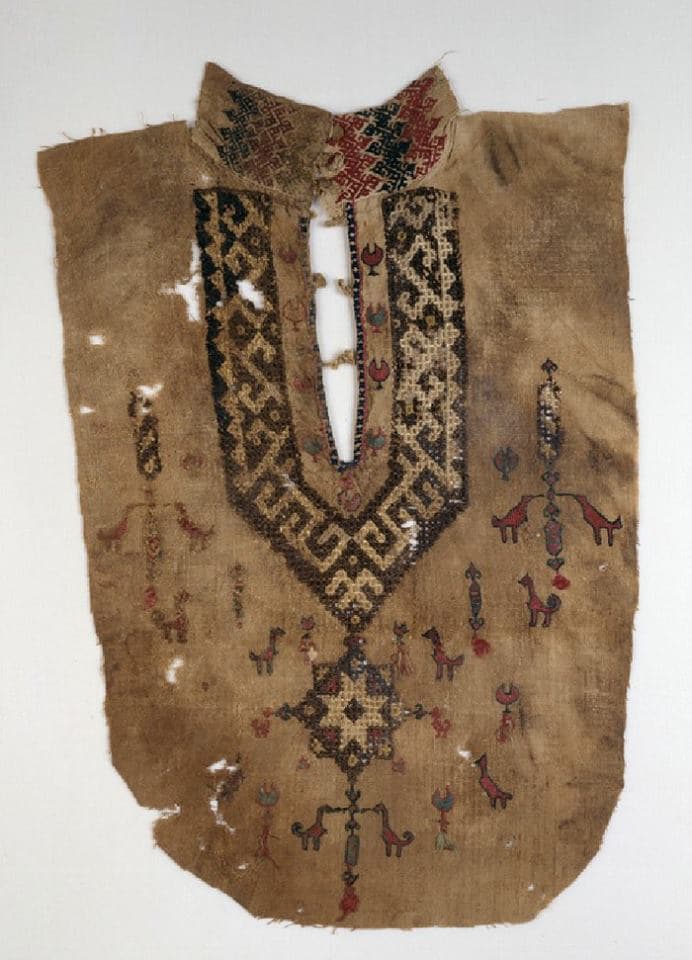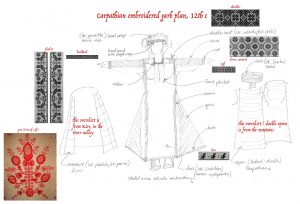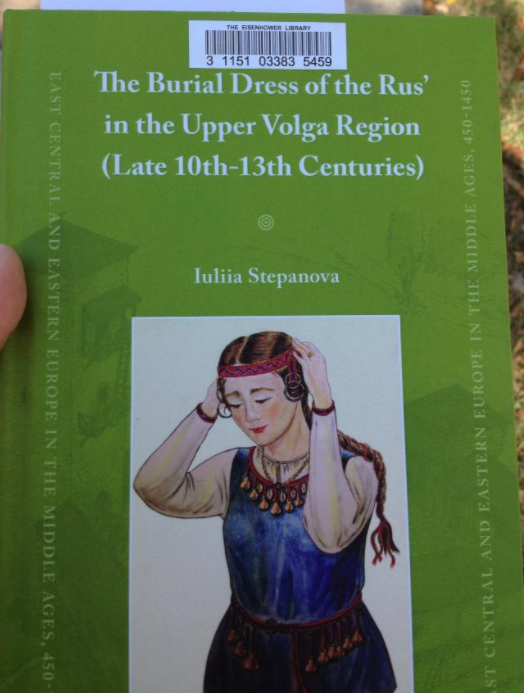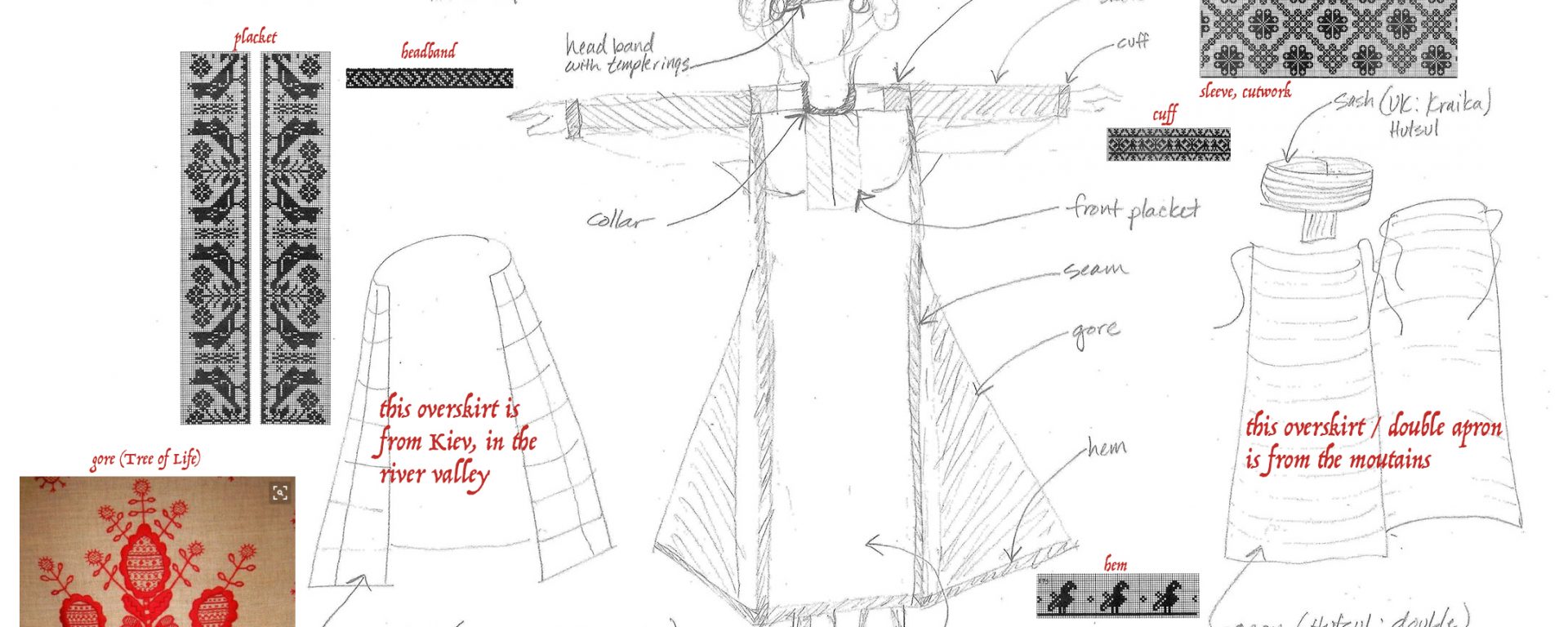(note: this is a bit of a digital scrapbook at the moment, as I collect things. I’ll be cleaning it up and elaborating via separate posts.)
Motivation for 12th century Carpathian
My husband decided (along with several hundred other folks) to adopt a new fighting persona in honor of a wonderful mentor of his who died too young. He shifted from 10th century Norman Viking to 3rd Crusade, Norman Templar, therefore about 1200 AD. I thought it might be nice to make an outfit from the 12th century Carpathian Basin to go along with him. (POSTMore details)
One location of interest –Uzhhorod, via Kiev
In 895 AD Hungarian tribes, headed by their leader Árpád, stormed the Hungvar fortress. The forces were not equal and Laborets was defeated and beheaded on the banks of the river that still carries his name. Again, this is mythical. There was not much of a settlement when the Magyar tribes arrived, having left Kiev (then known as Kevevara) and encountering no resistance.
After the arrival of the Hungarians, the small town began to extend its borders. In 1241–1242 the Mongols of Batu Khan burnt the settlement.
Earliest Citations for Clothing
- A Bronze Age clay figurine from Carpathian Basin, indicating accessories and decorations to her garments!!! (POSTMore details)
- Herodotus (425 BC) refers to Scythian’s clothes embroidered with different ornaments
- 6thC – Cherkassy male clothing, silver plates
Relations to Viking Age, aka the Rus
A number of folks have suggested to me that I look at the eastern Vikings and their routes, which are documented to Kiev. I agree that this seems plausible for the Viking period (dates). (POST ON GETTING FROM VIKING RELATIONSHIP)
(map of Rus routes)
Post-Viking, pre-Crusades
The Magyar period is thought of as really ending with the rise to power of Stephen, first king of a unified Hungarian state(DATES). Bela II, in (DATE), asked Franks to come settle in the Carpathians, who became known as the Transylvanian Saxons, a bit of a misnomer. (POST ON BOOK)
MAP
Based on this historian’s work tracing the origin of traditional motifs, I identified some I feel confident in using, and feel make sense. (POST)
Other embroidery design precedents
The gist I’m getting from reading on numerous “how to interpret folkwear” museum sites, is that since patterning is very personal and familial, I should design my own arrangement of these motifs, a bit like designing heraldry. (POST ON DESIGN)
In addition, there’s an extant embroidered veil from the Church of the Tithes (1240 AD) – STILL LOOKING FOR IMAGE
There’s some other embroidery references, but they swing away from this more direct line. UPDATE: Good stuff here at “Legacy of Ancestors”.
- Gizella’s cape for Stephen
-

Even the museum showing this part of their collection isn’t sure how this Mamluk piece got there. Mysterious 1000-yr-old fragment on Pinterest that lots of people have cited – UPDATE: Source now identified, you’ll need to use Chrome’s Translate button. It looks similar to the embroidery stitch type called Nyzynka, which is helpful for choosing a stitch type. It also shows ‘floating motifs’, which is also interesting and useful for creative design.
Other design considerations
Fabric
- The area is a linen producer
- White linen rather than natural or dyed
Color of thread
- White embroidery is thought to be ancient
- Red embroidery is appropriate to the time/place: “Native to Middle East, spread to northern Europe before 1066. Very fast dye…”
Type of embroidery stitches
I chose my historically-based embroidery patterns, and I’ve chosen the appropriate stitches, time to try them!(POSTS on how that went)
- Cross-stitch – can be dated to 15th century
- Cutwork
- Nyzynka – can use charted designs (POST on patterns and trials)
- Kalatoszegi – “written work”, a fat chain stitch (POST on patterns and trials)
So now that I know how hard these stitches are, I can do the graphic design necessary to lay the embroidery design out on my garment.
Dress assembly
I’ve found a fantastic folkwear historian in BLOG, who provided cutting layout and assembly for post-Renaissance folk tradtion garments. This is helpful for identifying that shoulder patch. He makes a distinction between later construction with a waist seam, and earlier constructions using a continuous tunic pattern. I don’t know yet when that shift happens. Given that my target year is 1200, I’m thinking I should shoot for a continuous tunic, more similar to the rest of Europe.
So I’m going to try a mix of the two – I’ll adopt the inset shoulder, that produces the distinctive smooth dropped shoulder with lower full sleeve. But I’ll use a typical tunic set with side gores.
DIAGRAM OF TUNIC ASSEMBLY
Eura dress (1000 Finland)- has smooth dropped shoulder
Complete garb layout with accessories

Accessories
Headwear (UK ‘peremitka’)
Headband
Temple rings
Overskirt (UK ‘plahkta’)
A checked overskirt, called a plahkta, makes a strong appearance in explanations of folk costume, which also appears in Bronze Age figurines…BARBER REFERENCE
Sash ( UK ‘krayka’)
Maybe this could be an indigo and weld dyeing project? It seems to be a rigid heddle woven thing…
Jewelry
Still puzzling this out – ‘traditional’ shows many strands of coral beads.
Important references:
http://honchar.org.ua/english/collection/
Foreigners in Early Medieval Europe – 2 papers on Carpathian finds in Migration period and Early Middle Ages (AD400-800). Contains Avar-age Germanic noblewoman artistic rendering of grave goods at Kolked-Feketekapu, grave 85.

Also:
A girl in Romanised costume, wearing a hair-net decorated with gold tubes, earrings with basket pendants, and a disc brooch. Keszthely, Fenékpuszta, Horreum, grave 9 (after Schulze-Dörlamm 1984)
Reconstruction of a Slavic woman’s headdress decorated with trapezoid pendants. Oroszlány grave 20 (after Sós 1958)
The Age of the Arpad Kings (11th-13th centuries) – an exhibition
Texts from this conference should be available after March 1, 2018. I’m interested in:
- Pásztókai-Szeőke – V. Kiss – G. Kulcsár – M. Mordovin – Z. Mráv – P. Polgár – I. Radman-Livaja – V. Szeverényi – I. Szathmári – I. Vida: Mixtura texturalis – recent research of archaeological textiles and textile production in Hungary
- K. Vajanto – M. Pasanen: Dyes and Dyeing Methods used in Finland 1000 Years Ago
Interlibrary loan to get:


